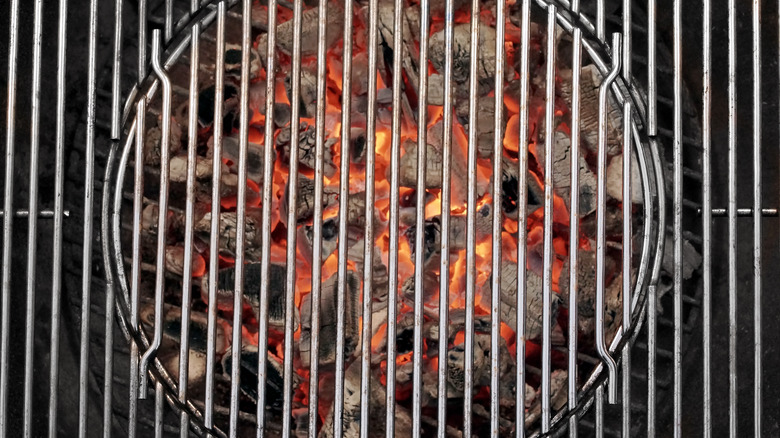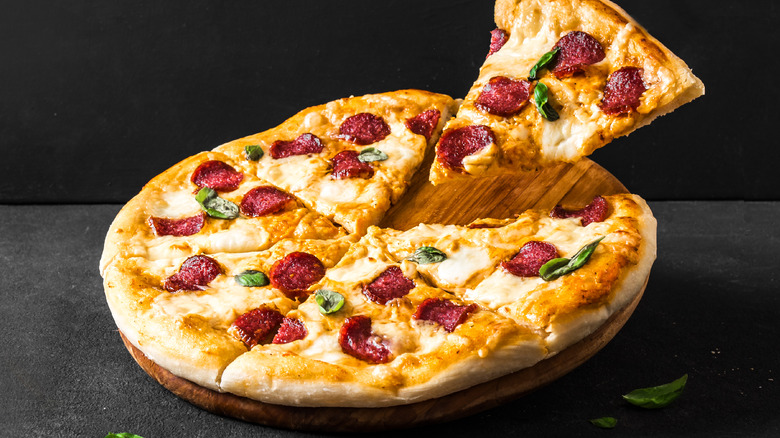The Technique J. Kenji Lopez-Alt Uses To Make Resturant-Quality Pizza
Pizza is one of the most recognizable foods around the globe. In 2021, pizza was the fifth most ordered cuisine on UberEats, according to its 2021 Cravings Report. After all, who doesn't love a crisp disk of dough topped with melted cheese, tomato sauce, and pretty much anything else you could dream of? While there are plenty of dedicated pizzerias, the Italian dish is also super easy to make at home. But you might find that it's a little different than what your local restaurant would serve.
The major difference between homemade pizzas and those you get from restaurants tends to come from the ovens. A home oven rarely goes above 550 degrees, while professional ovens and wood-fired ovens can generate temperatures up to 900 degrees (via The New York Times). The difference in heat is key; the higher temperatures produce an incredibly crispy, slightly charred crust while cooking the pizza through in a matter of minutes (via Crust & Craft). But J. Kenji Lopez-Alt may have cracked the secret for restaurant-quality pizza made in the comfort of your own home – or backyard.
The secret technique is firing up the grill
In an article for The New York Times, J. Kenji Lopez-Alt details that grilling his pizza is the secret technique he uses at home, a skill he picked up while working at a bar called Cambridge 1 after graduating college. Lopez-Alt says that the grill is the only piece of equipment the average person has in their home to rival the high heat of a professional wood-fired oven. While grilling pizzas sounds like it may be a complicated endeavor, the article outlines the simple steps that start after rolling out your pizza dough.
According to Lopez-Alt, "The trickiest part of the technique is draping the dough over the grill ... once it's on the grill, you won't be able to move it until the underside has cooked enough to hold its shape." Tossing the dough directly on the grate rather than using a cooking sheet or some other intermediary might seem intimidating, but it's vital to give the dough heat exposure to create an ideal crust. After the bottom is cooked, it's necessary to flip the crust and top the underside. Unlike in a traditional pizza oven – where the heat comes from all sides via convection, direct contact with the oven, and radiation (per Alfa) - the heat source of the grill comes from below and won't cook the dough on top before scorching the bottom crust.
How to elevate your home pizza
A proper technique isn't all that goes into making a great homemade pizza. While grilling skills can elevate a pizza, something as simple as a good pie also needs the right ingredients and toppings to really make the whole pie shine. Good pizza dough is critical to providing a solid foundation for the pizza and should be treated as more than a delivery vehicle for cheese and toppings – after all, toppings can't salvage a low-quality crust (via Pizza University).
Perhaps the most pressing choice comes in the quality and amount of ingredients put onto the pizza. One pitfall to avoid is loading the pizza up with too many toppings. Instead, it's better to focus on high-quality ingredients that will complement each other and not overwhelm the simple beauty that is a pizza (via Serious Eats). Another way to ensure your toppings stand up to your technique is to make sure that toppings like vegetables and meats are cooked before going on top of the pie as the short time on the grill won't cook them through and could just release a bunch of unwanted water or oil across the pizza (via Food Network).


